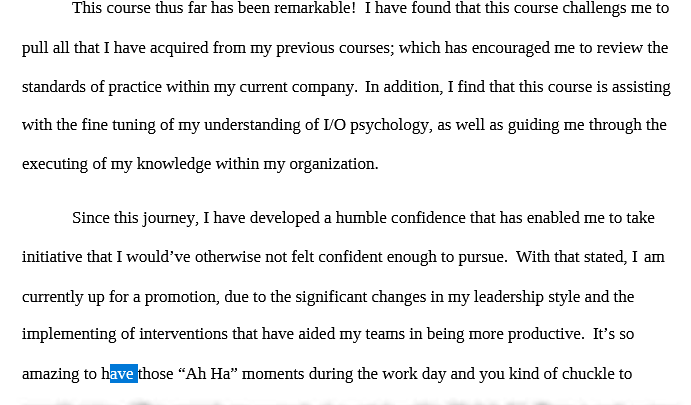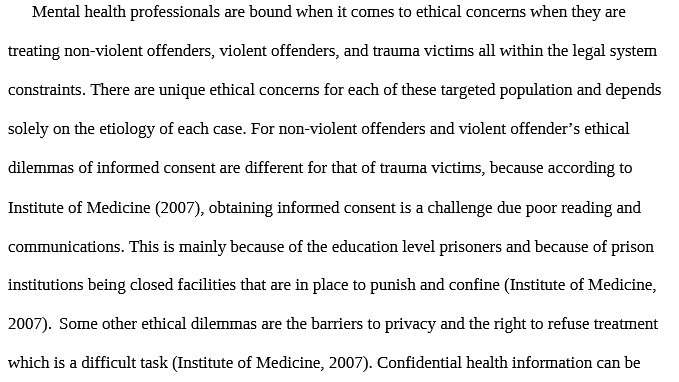PSY 638 Module 7-1 Discussion Issues with Young Children.docx – Snhu
$3.99
PSY 638 Module 7-1 Discussion Issues with Young Children.docx – Snhu
In the video, Curing Kids with Extreme Social Phobias the children were afraid to speak to strangers (adults and children) and were diagnosed with selective mutism. A CBT boot camp was utilized to help them address their fears and with the assistance of trusted loved ones, the children were able to begin communicating with strangers. Beidel, et al (1998) defines anxiety disorders as a mental diagnosis characterized by levels of anxiety that impair one’s ability to properly function. Social phobia diagnoses are sub-categorically defined as excess levels of stress and inhibition in one’s engagement with social situations that may involve personal attention and assessment (Beidel, et al, 1998). Kashdan and Herbert (2001) noted that social phobia in children is not diagnosed if social anxiety is only prevalent around adults. Childhood social anxiety must be present when the child engages with their peers. Social phobia is a disorder, presenting in children as young as 8-years-old, who have an extreme fear of completing activities such as reading, speaking, writing, or eating in a public setting(Beidel et al., 2000). Public places, in terms related to the phobia, are defined as parties, and public restrooms and may include speaking to authority figures or speaking to people in a social setting such as school or other places. Although
Description
PSY 638 Module 7-1 Discussion Issues with Young Children.docx – Snhu
In the video, Curing Kids with Extreme Social Phobias the children were afraid to speak to strangers (adults and children) and were diagnosed with selective mutism. A CBT boot camp was utilized to help them address their fears and with the assistance of trusted loved ones, the children were able to begin communicating with strangers. Beidel, et al (1998) defines anxiety disorders as a mental diagnosis characterized by levels of anxiety that impair one’s ability to properly function. Social phobia diagnoses are sub-categorically defined as excess levels of stress and inhibition in one’s engagement with social situations that may involve personal attention and assessment (Beidel, et al, 1998). Kashdan and Herbert (2001) noted that social phobia in children is not diagnosed if social anxiety is only prevalent around adults.
PSY 638 Module 7-1 Discussion Issues with Young Children.docx – Snhu
Childhood social anxiety must be present when the child engages with their peers. Social phobia is a disorder, presenting in children as young as 8-years-old, who have an extreme fear of completing activities such as reading, speaking, writing, or eating in a public setting(Beidel et al., 2000). Public places, in terms related to the phobia, are defined as parties, and public restrooms and may include speaking to authority figures or speaking to people in a social setting such as school or other places. Although the symptoms of a social phobia are similarly expressed in both children and adults, children may express their symptoms more noticeably. Symptoms that define a social phobia in children are extreme headaches and stomach aches, generalized panic attacks, abnormal behaviors (such as withdrawing from a social setting), and crying (American Psychiatric Association & American Psychiatric Association, 2013).
PSY 638 Module 7-1 Discussion Issues with Young Children.docx – Snhu
Children that present with a social phobia typically have comorbidity with anxiety, depression, or another mood disorder and may also spend a significant amount of time alone and have few or no Anxiety disorders are a defined mental diagnosis that is characterized by“levels of anxiety that impair one’s ability to properly function” (Beidel et al.,1998). One type of condition is labeled as social anxiety or social phobia. Beidel et al. (1998) highlighted that a diagnosis is sub-categorically defined as excess levels of distress and inhibition in one’s engagement with social situations that may involve personal attention and assessment. From a clinical perspective, social anxiety presents as a phobia of one’s engagement with social situations. According to Kashdan and Herbert (2001), social phobia in children is not diagnosed if social anxiety is only prevalent around adults. Childhood social anxiety must be evident in the child’s engagement with their own peer group. For those under the age of 18 years old, to be diagnosed, the duration must be present for at least 6 months. Children may express social phobias differently than adults. It is highlighted that the prevalence of social anxiety in children and adolescents ranges from 4% to 9% (Kashdan & Herbert, 2001). Social phobia is statistically less common in males than in females (Wittchen & Fehm, 2003).
PSY 638 Module 7-1 Discussion Issues with Young Children.docx – Snhu
- PSY 211 – Lifespan Development (5015 Documents),
- PSY 215 – Abnormal Psychology (4335 Documents),
- PSY 108 – Introduction to Psychology (3759 Documents),
- PSY 223 – Statistics for Psychology Research (2652 Documents),
- PSY 216 – Psychology of Personality (1841 Documents),
- PSY 510 – Research Methods (1748 Documents),
- PSY 520 – Research Methods in Psychology II (1469 Documents),
- PSY 257 – Psychology (1451 Documents),
- PSY 310 – Criminal Psychology (1393 Documents),
- PSY 200 – FOUNDATIONS OF ADDICTIONS (1379 Documents),
Only logged in customers who have purchased this product may leave a review.







Reviews
There are no reviews yet.